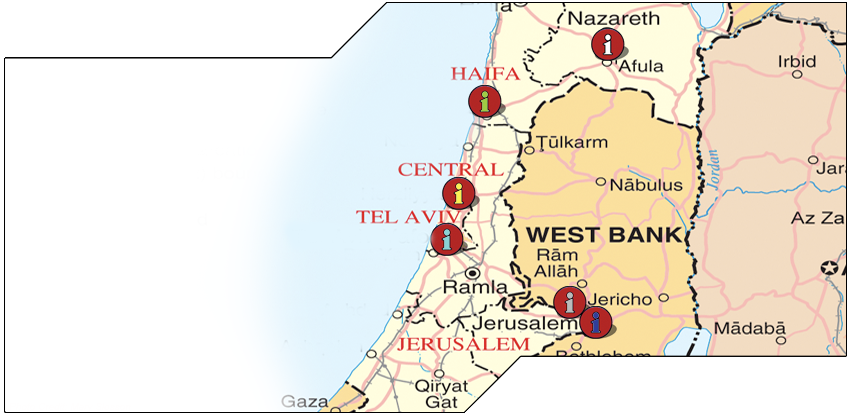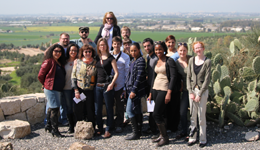

Travel Destinations
 |
Jerusalem |
 |
East Jerusalem |
 |
Nazareth |
 |
Haifa |
 |
Jaffa |
 |
Tel-Aviv |
J585 ITINERARY 2011
FRIDAY, MARCH 11, 2011: ORIENTATION
Shabbat Dinners
Location: Local homes
SATURDAY, MARCH 12: SETTING THE SCENE
Morning Old City Tour — Where History Meets the Present
Participants will gain a deeper understanding of the centuries-long longing for Jerusalem by the diverse groups of people living here today.
Tour of East Jerusalem
Sheikh Jarrah, Separation Barrier, Silwan – understand the political contentions around Jerusalem and the hot zones of East Jerusalem, meet with local residents and community leaders.
Guide: Orly Noy
Dinner — Prospects for Peace
Yossi Klein Halevi, journalist and author
SUNDAY, MARCH 13: TENSIONS WITHIN THE JEWISH POPULATION
Tensions between Ashkenazi and Mizrahi Communities
Visit to the Kedma School and Katamon community center.
Israeli-Palestinian Dialogue Encounter
Meeting with the Parents Circle Families Forum.
Speakers: Siham Abu Awad and Aron Barnea
MONDAY, MARCH 14: MIXED CITIES
Tour Lod
Meet with community activists, visit demolition sites.
Tour Artists District in Ramle
Learn about housing, infrastructure, educational, social, cultural and economic services. Meet local artists.
Arrive in Nazareth
TUESDAY, MARCH 15: PALESTINIAN CITIZENS OF ISRAEL
Umm-al-Fahm
Visit to Gallery of Arab Art, meet with Director Said Abu Shakra.
Barta’a
Meeting with Muslim families divided by the Green line.
Dinner with Atallah Mansour, Arab-Israeli journalist
WEDNESDAY, MARCH 16: CO-EXISTENCE
Meeting with Jonathan Cook, freelance journalist
Palestinian Citizens in the Israeli Workforce
Participants will break off into groups and meet with various young Palestinian citizens of Israel representing different components of the workforce from hi-tech to media.
Speakers: • Sami Saadi, Founder, TSOFEN; Bassel Khoury, Galil Software; Nur Fahom – PR in the Arab sector
THURSDAY, MARCH 17: HAIFA
Co-Existence through Art
Meet with Israeli Arab and Jewish young artists to discuss the use of art to reflect issues of co-existence; Hear from Israeli-Palestinian artists on Arab cultural realities and directions in Israel.
Location: Neri Bloomfield School of Design and Education
Program with Haifa University
Discussion of Israeli Arab issues, gender issues and prospects for co-existence with local scholars.
Prof. Mary Totry, Department of Communication; Prof. Michele Rosenthal, Department of Communication; Prof. Ayman Agbaria, Department of Education; Prof. Jonathan Cohen, Department of Communication
FRIDAY, MARCH 18: HAIFA AS A MICROCOSM
Beit Hagafen Arab-Jewish Center
Assaf Ron, director, meeting on Haifa's diverse population long tradition of tolerance and example of an alternative to shared living for Arabs and Jews in Israel.
Women as Agents of Change
Meet with representatives from women’s organizations committed to stimulating empowerment for women.
Participants: Isha Li'Isha, Kayan-Feminist Organization
Minorities in Israel: The Druze Community of Ussefiya
Meet with residents to discuss Druze history and the community's relations with Muslims, Jews and the Israeli government.
Traditional Druze dinner
SATURDAY, MARCH 19: PURIM HOLIDAY EVE
Discussion with Community Leaders and Activists
Popular Committee Jaffa – leaders in community development work, housing rights and representing the Palestinian citizens of Jaffa.
Group Discussion – Conclusions and Insights
Location: Yaffa Café

Student Reporters Take On the Mideast Beat

By Diane Winston
January 16, 2011
Wedged into a small van, the students in my journalism class jostle and bounce along rutted West Bank roads. Their fatigue is real, but it's no match for their eagerness to discuss the family we'd just visited in Hebron.
The Abu 'Ayesha clan lives inside a chain-link cage. In 1996 family members encircled their two-story house with a metal fence to protect against stones flung by the children of neighboring settlers, Jews reclaiming what they say is their biblical heritage. Soon after the settlers arrived, the entire Arab community fled. Only the Abu 'Ayeshas refused to leave, choosing a path of isolation and adversity.
Does the decision to stay in their home serve their family and the Palestinian cause? Or does it fuel the grim determination of Jewish settlers bent on driving them out? Perhaps there another story to be told? The students argue these and other points with fervid intensity.


